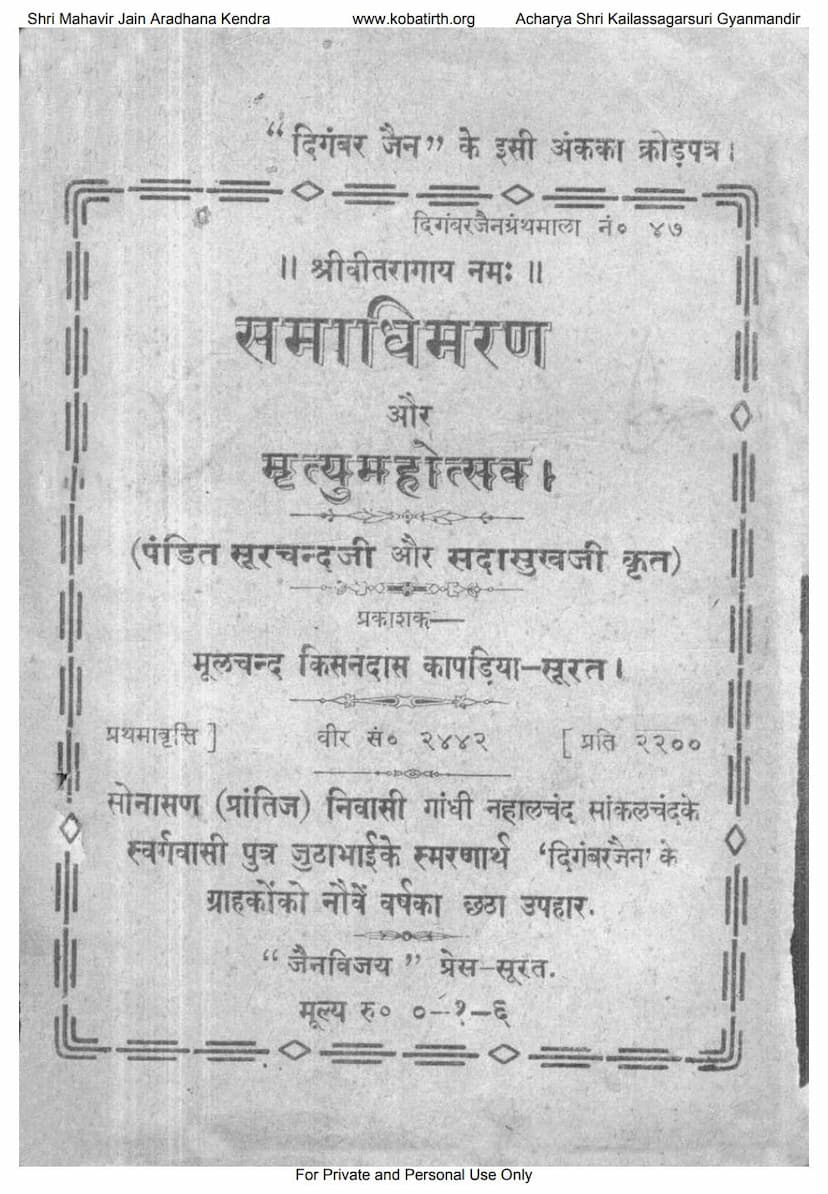Samadhi Maran Aur Mrutyu Mahotsav
Added to library: September 2, 2025

Summary
Here's a comprehensive summary of the Jain text "Samadhi Maran Aur Mrutyu Mahotsav" by Surchand, based on the provided pages:
The book, Samadhi Maran Aur Mrutyu Mahotsav (Equanimous Death and the Festival of Death), published by Mulchand Kisandas Kapadia, is a Jain text that expounds on the concept of achieving a peaceful and spiritually beneficial death, viewing it not as an ending but as a "festival" or a transition to a new phase, ultimately leading to liberation.
Core Themes and Teachings:
The central argument of the book is that death, when approached with equanimity and spiritual preparedness, is a joyous occasion that facilitates a higher rebirth or even liberation (moksha). It encourages readers to shed the fear of death and instead embrace it as a natural part of the soul's journey.
Key Concepts Discussed:
- Samadhi Maran (Equanimous Death): This is the ideal way to die in Jainism. It means dying with a calm, stable mind, free from attachment, aversion, and the distress caused by physical pain or emotional turmoil. It involves remembering the soul's true nature and meditating on the Divine.
- Mrutyu Mahotsav (Festival of Death): The book reframes death as a celebration. This perspective arises from the understanding that a well-lived life, culminating in a peaceful death, is a cause for rejoicing as it marks the shedding of an old, worn-out body and the transition to a new, potentially more favorable existence.
- The Soul's True Nature vs. the Body: A significant portion of the text emphasizes the distinction between the eternal, conscious soul (atma) and the transient, physical body (sharir). The body is described as impure, decaying, and a source of suffering, composed of earth, water, fire, and air elements. The soul, on the other hand, is described as pure consciousness, knowledge, and bliss, existing independently of the body.
- The Cycle of Birth and Death (Samsara): The text acknowledges the soul's endless journey through various life forms (human, animal, celestial, infernal) driven by karma. It highlights the suffering inherent in this cycle, particularly the pain and distress associated with "kumaran" (ignorant or distressed death).
- The Importance of Spiritual Practices: To achieve Samadhi Maran, the book stresses the necessity of lifelong spiritual practices, including:
- Right Faith (Samyak Darshan): Believing in the teachings of the Tirthankaras and the nature of reality.
- Right Knowledge (Samyak Gyan): Understanding the true nature of the soul and the universe.
- Right Conduct (Samyak Charitra): Living according to Jain ethical principles, including non-violence (ahimsa), truthfulness (satya), non-stealing (asteya), celibacy (brahmacharya), and non-possession (aparigraha).
- Austerities (Tapas): Engaging in practices like fasting, meditation, and self-discipline to purify the soul and burn off karma.
- Meditation and Contemplation: Focusing the mind on the soul's true nature and the virtues of the liberated souls.
- Letting Go of Attachments: The book strongly advises against attachment to family, possessions, and even the physical body itself. It explains that these attachments lead to suffering at the time of death and hinder the soul's progress.
- The Role of Karma: Karma is presented as the binding force that keeps the soul in the cycle of rebirth. Death is an opportunity to shed karma through proper spiritual practices and an equanimous mindset.
- Examples of Great Souls: The text recounts the lives of numerous Jain monks and ascetics who faced immense suffering and hardship (upasaraga) with unwavering equanimity and faith, ultimately achieving Samadhi Maran. These examples serve as inspiration for the reader. Notable among them are:
- Sukumar Muni: Endured the suffering caused by his sister-in-law and her children.
- Sukaushal Swami: Devoured by a tigress.
- Gajmuni: His head was set on fire.
- Sanatkumara Muni: Suffered from a debilitating skin disease.
- Shrenik: A king who embraced Jainism.
- Samantabhadra Muni: Endured extreme hunger.
- Chilati Putra: Suffered from the attacks of insects on his body.
- Dandak Muni: Pierced by arrows.
- Abhinandan Muni: Crushed by an oil press.
- Chanak Muni: Burned alive on a pyre.
- The Five Pandavas: Adorned with iron ornaments.
- The Nature of Suffering: The text emphasizes that the pain experienced during illness or at the time of death is primarily a result of the physical body and the karmic predispositions. The soul, being pure consciousness, is unaffected by these external conditions if one maintains equanimity.
- Death as a Friend: The book personifies death as a benevolent friend who liberates the soul from the prison of the physical body.
- The "Fourfold Sustenance" (Chatur Aradhana): This refers to the four fundamental practices for spiritual progress and a good death: faith, knowledge, conduct, and austerity.
- Call to Action: The book concludes with a strong exhortation for readers to practice these principles diligently throughout their lives, so that when the time of death arrives, they can face it with joy and achieve liberation.
Overall Message:
Samadhi Maran Aur Mrutyu Mahotsav is a profound spiritual guide that aims to transform the reader's perspective on death. It teaches that by living a life of virtue, detachment, and devotion to Jain principles, one can transcend the fear of death and embrace it as a gateway to spiritual fulfillment and ultimate liberation. The emphasis is on cultivating inner peace, equanimity, and a deep understanding of the soul's true, eternal nature.